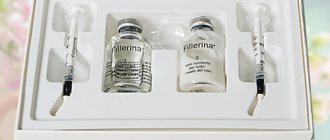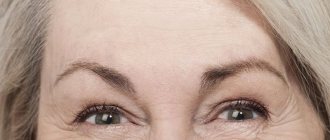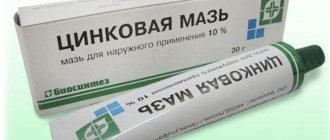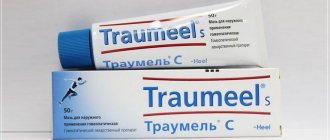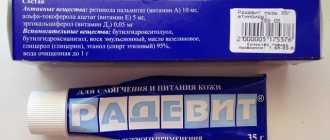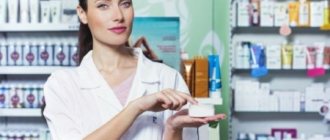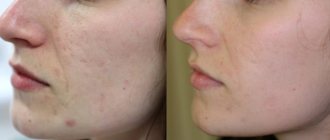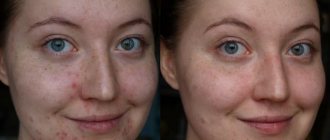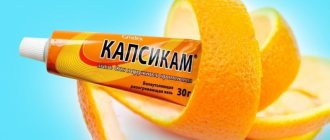To preserve the beauty and youth of their skin, women mainly use cosmetics, but recently there has been an increased interest in pharmaceutical preparations. Retinoic ointment has a powerful anti-inflammatory and dermatoprotective effect. Let’s look at what helps and how to use it correctly.
What the instructions say
The main component of the product is isotretinoin, a synthetic analogue of retinol (vitamin A) . This substance was previously used to treat cancer, as it can stop the division of cancer cells. Then they discovered another property of isotretinoin - it is able to regulate the functioning of the fatty glands and reduce the growth of epithelium in the excretory ducts.
Let's look at how retinoic ointment works and why it helps when applied externally:
• restores skin;
• accelerates regeneration processes;
• improves cellular metabolism;
• acts as an immunomodulator;
• reduces sebum production;
• cleanses pores.
The main purpose of retinoic ointment is to combat skin inflammation; it is used to treat acne, blackheads, seborrheic dermatitis, rosacea, and ichthyosis.
Isotretinoin is used in the fight against age-related facial aging, age spots and wrinkles. It is known that a lack of vitamin A causes the skin to become dry, flabby and wrinkled. Retinoids included in the ointment help slow down fading. They even out skin texture, improve complexion, and moisturize the skin. The components of the ointment penetrate deeply into the lower layers of the dermis and act at the level of dermal stem cells. They help produce your own collagen and ensure cell renewal.
Retinoic ointment is available in concentrations of 0.1% and 0.05%. It is yellowish in color, non-sticky, and is easily absorbed by the skin. In addition to isotretinoin, it contains:
• Butyloxyanisole – antioxidant;
• Glycerin and petroleum jelly are substances that additionally soften and moisturize the dermis;
• Ethyl alcohol is an antiseptic component;
• Wax – it acts as an emulsifier, provides hydrophilicity and is responsible for the texture of the ointment.
What to remember
- Retinoic ointment reduces the production of melanin in epidermal cells, which helps clear the skin of pigmentation or reduce its appearance.
- As a synthetic analogue of vitamin A, retinoic ointment has a positive effect on the condition of the skin, activates the growth of new cells and slows down the aging process.
- To ensure that the use of retinoic ointment for pigment spots does not cause complications and does not have a reverse effect, strictly adhere to the instructions and do not neglect contraindications.
For acne and comedones
The pharmaceutical drug can be used in the fight not only against juvenile acne, but also against acne in adulthood. Retinoic acne ointment helps even in advanced cases when there are subcutaneous nodules and papular-pustular rashes. It is used for acne and inflammation on the body.
Let's look at how retinoic acne ointment works:
1. The thickness of the epidermis decreases. When applied to the skin, the ointment has a slight irritating effect, as a result of which the cells of the surface layers of the skin exfoliate and fall off. A peeling effect occurs. As a result, the pores open and sebum stops accumulating in them.
2. Dissolves sebaceous plugs that clog pores. This property of retinoic ointment is used in the fight against comedones.
3. Reduces the activity of fatty glands , due to which acne is eliminated. After all, the main reason for their formation is excess sebum, which clogs the excretory ducts.
Allergic reactions are possible when using retinoids, so a skin test should be performed first. A small amount of ointment is applied to the elbow. If after 30 minutes itching, redness, or hives appear in this area, the product should not be used.
Contraindications and possible harm
An affordable price and good reviews have ensured that retinoic ointment is in demand in the fight against age spots. Caution should be exercised by people who are allergic to the components of the drug, as well as in the presence of contraindications indicated in the list:
- pregnancy and lactation;
- chronic pathologies of the liver, kidneys, pancreas;
- children under 12 years of age;
- a large amount of vitamin A in the body;
- heart failure;
- inflammatory skin diseases;
- high blood lipid levels.
Even if all safety measures are taken, the skin begins to peel off within the first 24 hours after the procedure. This is a normal reaction during which the dermis is released from dead cells. If peeling continues and is accompanied by redness within 3-4 days, stop treatment and consult a dermatologist.
The reason for refusing to use retinoic ointment for pigment spots should be itching, increased dryness of the skin, swelling, skin rashes, conjunctivitis, pain in the joints and gastrointestinal tract.
Rules for using retinoic acne ointment
The product is applied only to cleansed and dried skin; it is not recommended to use a scrub for these purposes. In the presence of severe acne, use the product in a concentration of 0.1%. As the inflammatory elements on the skin decrease, they switch to a low concentration.
Apply the ointment pointwise to problem areas 2 times a day until completely absorbed; no need to rub in. The course of treatment should not last more than 12 weeks; in any case, a preliminary consultation with a dermatologist is required.
The most commonly used scheme is:
• 1-2 weeks – 0.1% ointment twice a day;
• 3 week – 0.05% concentration 2 times a day;
• 3 week – the product is used 1 time per day;
• Week 4 – applied every other day.
Judging by the reviews of dermatological patients, there is no dramatic improvement in appearance. On the contrary, a week after the start of treatment, peeling, redness appears, and acne worsens. This is due to the fact that dead cells are removed from the surface of the epidermis, and the activity of the sebaceous glands decreases. To reduce these manifestations, you can use compresses with decoctions of medicinal herbs.
Since retinoids have a rather active effect on the skin, it is recommended to use only mild moisturizing cosmetics during the treatment period. Which do not cause irritation. This could be baby milk or cream from the pharmacy. Additionally, you cannot apply other anti-acne medications to your face.
After 2 weeks, the condition improves: acne goes away, the skin looks clean and radiant. Some comedones disappear on their own, the rest disappear after mechanical removal.
Let's look at what retinoic ointment won't help with. The product is ineffective in the presence of subcutaneous scars, severe keratinization, and furunculosis.
Instructions for use
Before using Retinoic acne ointment, you must thoroughly cleanse the skin. The deeper it penetrates into the pores, the stronger the therapeutic effect will be. After washing with soap, the face is wiped with antiseptic solutions or infusions of medicinal herbs:
Experts recommend carrying out therapy during the cold season. The fact is that isotretinoin increases susceptibility to ultraviolet rays. Using the drug in summer may cause the appearance of new age spots.
During the period of eliminating acne and wrinkles, it is necessary to additionally moisturize the skin with gels and creams with a light structure. Do not apply Retinoic ointment to areas with thin epidermis - around the eyes or mouth.
Indications and contraindications
In dermatological practice, Retinoic ointment is used in the treatment of papulopustular acne and seborrhea. A course of use of the drug allows you to quickly get rid of rosacea and perioral dermatitis.
In cosmetology, Retinoic ointment is recommended for various skin defects:
- black spots on the nose, chin, forehead and cheeks;
- pigment spots of any location.
With the help of a pharmaceutical drug, women get rid of facial wrinkles and prevent the formation of new ones.
The drug is not prescribed to pregnant and breastfeeding women. It is contraindicated in case of hypersensitivity to one of the ingredients. The drug should be used with caution in severe pathologies of the liver and urinary organs.
Directions for use and doses
Retinoic ointment should be used for both pimples and comedones in accordance with medical recommendations. You should not violate the dosage regimen in the hope of speeding up skin cleansing.
The drug is applied pointwise to inflamed areas of the skin 1-2 times a day. It is advisable to carry out the treatment procedure before bedtime. Overnight, isotretionine is completely absorbed by the epidermis and will have maximum effect. To get rid of acne faster, you should regularly apply the drug, rubbing it lightly.
Features of use for acne
Retinoic ointment effectively treats any form of acne. It eliminates subcutaneous acne and pimples located on the surface of the skin.
The relative toxicity of the drug requires careful use.
A few days after the start of therapy, acne may recur. New acne and small pimples form. After continued treatment they quickly disappear.
Side effects
When using an external agent, a local adverse reaction may develop. Skin itching occurs, the epidermis swells and turns red at the sites of application. The following negative effects of isotretinoin occur much less frequently:
- conjunctivitis;
- cheilitis;
- excessive dry skin;
- severe exfoliation of the upper epidermal layer.
Any of the symptoms becomes a reason to discontinue the drug. The dermatologist will prescribe its analogue or adjust the dosage regimen.
Retinoic ointment for wrinkles
The anti-aging properties of the ointment were not immediately discovered. After acne treatment, a miraculous transformation occurred: not only pimples and “blackheads” disappeared, but also shallow wrinkles. The skin became smoother, acquired tone and elasticity. This gave rise to the use of retinoic ointment for wrinkles. Its results in the rejuvenation process depend on the following:
• Isotretinoin acts as a chemical peel. After use, the upper dead cells are removed and the thickness of the stratum corneum is reduced.
• Isotretinoin acts on keratinocytes , the lowest cells of the epidermis. They begin to divide intensively, and skin renewal occurs. The resulting young cells attract water molecules, which increases the hydration of the dermis.
• Stimulates the production of your own connective tissue . As a result, the skin becomes elastic.
Rules for using retinoic ointment for wrinkles:
• Vitamin A analogue is applied to clean skin, preferably in the evening.
• Distribute in a thin layer, paying attention to problem areas - where wrinkles are more noticeable.
• Do not apply under the eyes or around the nose and mouth.
• Leave the ointment until completely absorbed, after 20 minutes the excess is removed with a napkin.
• After the end of the exposure time, wash the face with water and apply a moisturizer.
• Anti-aging procedures continue for 2-4 weeks.
Cosmetologists advise using the ointment in the off-season - in autumn and spring, when there is no significant solar insolation. Retinoids increase skin sensitivity to ultraviolet radiation, so pigment spots may appear. For the same reason, you should not sunbathe or visit a solarium during the procedure. Before going outside, you need to apply sunscreen.
Retinoic ointment for rejuvenation can be used from the age of 30, when the first signs of withering appear. So in the case of acne, you don’t need to wait for an immediate effect. A single use of a pharmaceutical product will not give an impressive result, but course use improves the condition of the dermis. The skin tone is evened out, it is cleansed and looks fresh.
Indications for use
Anti-wrinkle ointment is primarily used for dry, aging skin. The oily, rather heavy structure can clog pores, causing comedones. Therefore, it is used in the treatment of acne with other drugs in a targeted manner, directly in the area of inflammation.
Indications for use are:
- dry, sensitive skin;
- stretch marks due to loss of elastin;
- bruises under the eyes;
- for dermatitis;
- facial and static wrinkles;
- laxity of the integument.
You can get rid of acne with the help of retinoic gels and creams, which have a lighter structure than ointment. And you can get rid of scars left after acne by using this drug.
Contraindications
Like any pharmaceutical product, it has its limitations for use.
- pregnancy, lactation period;
- liver diseases;
- drug therapy, including antibiotics;
- hypervitaminosis;
- individual sensitivity;
- increased greasiness of secretions.
Side effects:
- dry skin;
- the occurrence of irritation and peeling;
- the appearance of comedones, greasy shine;
- redness, itching of the integument;
- increased intracranial pressure, headache;
- depression, mood swings.
Prices and where to buy?
Like any cosmetic drug, it is sold without a prescription. Prices at the pharmacy depend on the chosen network and volume, the range ranges from 150 rubles. up to 300 rub.
